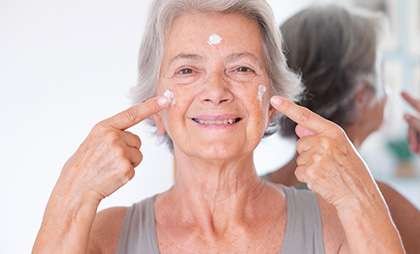Age Spots

WHAT ARE AGE SPOT TREATMENTS?
Age spots, also known as liver spots or solar lentigines, are small, flat, darkened areas of the skin.
Age spots are harmless and do not pose any health risks. Typically they appear on sun-exposed areas, such as the face, hands, shoulders, and arms. They are most commonly found in individuals over 50. However, they can also occur in younger people. The primary cause of age spots is prolonged exposure to ultraviolet (UV) radiation from the sun or tanning beds. It’s crucial to know that exposing yourself to the sun can damage skin cells and increase melanin production. Melanin is the pigment that gives color to our skin, hair, and eyes. As we age, melanin can accumulate in certain areas, resulting in the formation of age spots. Age spots can vary in size, shape, and color, ranging from light brown to black. These could indicate a potential skin cancer risk. While age spots are generally harmless; however, monitoring changes in size, shape, or color is essential. Consult a board-certified dermatologist or healthcare professional if you notice any changes or have skin concerns.
HOW TO TREAT AGE SPOTS?
Several treatment options can help reduce the appearance of age spots or remove them entirely. It is essential to consult with a dermatologist or healthcare professional to determine the most appropriate treatment for your situation. That maintains your skin tone and has zero side effects. Some common treatments for age spots include:
- Topical creams: Over-the-counter or prescription creams containing hydroquinone, glycolic acid, kojic acid, or retinoids. Those types can help lighten dark spots and maintain skin color symmetry by inhibiting melanin production. Be patient; it may take several weeks or months to see results.
- Chemical peels: A chemical peel involves applying a chemical solution to the skin, which causes the top layers to peel off. As the skin heals, the appearance of age spots may be reduced. Multiple treatments may be needed for optimal results.
Laser therapy: Laser treatments can target melanin-producing cells without damaging the skin’s surface. This treatment may require multiple sessions and can effectively reduce the appearance of age spots.
Intense pulsed light (IPL) therapy: IPL uses broad-spectrum light to target the melanin in age spots. It breaks down the pigment and reduces its appearance. Like laser therapy, IPL usually requires multiple sessions for the best results.
Microdermabrasion: This treatment involves using a particular device to gently exfoliate the skin’s surface, removing the top layer and promoting new skin growth. Microdermabrasion can help reduce the appearance of age spots, but multiple treatments are often required.
Dermabrasion: Similar to microdermabrasion, dermabrasion involves removing the top layers of the skin with a rotating brush or another abrasive tool. This treatment can be more aggressive than microdermabrasion and may require local anesthesia or sedation.
While these treatments can help reduce the appearance of age spots, they may not prevent new ones from forming. It is important to note that.
To minimize the risk of age spots, you must avoid sun exposure as much as possible. Also, you must protect your skin from the sun by wearing a broad-spectrum sunscreen with an SPF of at least 30, avoiding peak sun hours, and wearing protective clothing, hats, and sunglasses.




